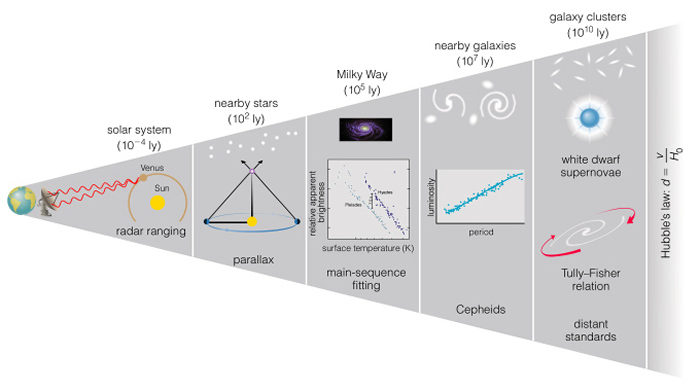cosmic distance ladder

The cosmic distance ladder is the chain of overlapping methods by which astronomers establish a distance scale for objects in the universe, from nearby planets to the most remote quasars and galaxies. At every step of the distance ladder, errors and uncertainties creep in. Each step inherits all the problems of the ones below, and also the errors intrinsic to each step tend to get larger for the more distant objects; thus the spectacular precision at the base of the ladder degenerates into much greater uncertainty at the very top.
Distances within the Solar System are known to extreme accuracy by a variety methods, including the motions of the planets in the sky, radar, and timing of signals from interplanetary probes. Distances to stars within a couple of thousand light-years come from various geometrical methods; the most accurate values are those based on measurements of the annual parallax of about 10,000 nearby stars made by the Hipparcos satellite. The moving cluster method can be applied over a similar range, while main-sequence fitting works with open clusters out to a distance of about 60,000 light-years.
Beyond the Milky Way Galaxy, distances can be established most reliably using the period-luminosity relation of Cepheid variables, backed by similar observations of other bright stars whose intrinsic brightness is reasonably well-known, including RR Lyrae stars and novae. This method can be applied out to the limit at which Cepheids and other individual stars can be distinguished inside their host galaxies - up to about 100 million light-years. For more distant galaxies, standard candles brighter than Cepheids are needed. These include globular clusters and Type Ia supernovae, which can be calibrated as distance indicators using Cepheids in relatively nearby galaxies and then applied further afield-up to about 200 million light-years for globulars and out to at least 3 billion light-years for supernovae. At the furthest limits, only whole galaxies are detectable, so methods such as the Tully-Fisher relation and Faber-Jackson relation are used, which link measurable properties of galaxies, or clusters of galaxies, to their luminosity. Extragalactic distance indicators enable estimates to be made of the Hubble constant, a measure of the rate at which the universe as a whole is expanding. Observation of the redshift of a remote galaxy or quasar then supplies the object's distance. Over time the accuracy to which the Hubble constant is known has improved dramatically. The most recent determination, using data from the Spitzer Space Telescope has narrowed the uncertainty down to just 3%.


